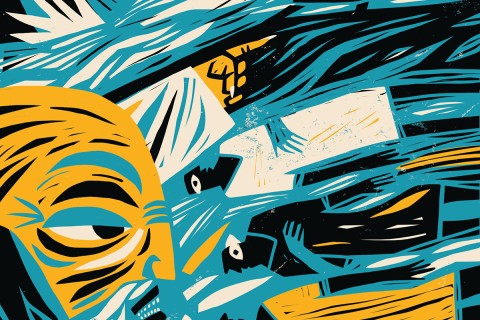New Smithsonian museum aids Baylor’s preservation of black gospel recordings
One professor’s quest to preserve historic black gospel music earned the attention of the Smithsonian Institution.
The Smithsonian’s recently opened National Museum of African American History and Culture in Washington, D.C., features a permanent exhibit, Musical Crossroads, on African-American musical history. It includes materials from a project at Baylor University, a Christian school in Waco, Texas, to save recordings from the “golden age” of American black gospel music.
An interactive display featuring “The Old Ship of Zion,” one of the key recordings of Baylor’s Black Gospel Music Restoration Project, is among the highlights of the exhibit.
The Smithsonian recognition helps preserve a vital part of American life, said project founder Robert F. Darden, a journalism, public relations, and new media professor at Baylor.
“These recordings are priceless, irreplaceable, and historic in a way that scholars are only now realizing,” Darden said.
The opening coincides with the ten-year anniversary of the project, begun at Baylor to identify, acquire, preserve, digitize, and catalog recordings from the black gospel music tradition. Many of those recordings made from 1945 to 1975 were vanishing as albums made the transition from vinyl to CDs. While albums by such legends as Mahalia Jackson are readily available, only a few by lesser-known greats could be found.
Read our latest issue or browse back issues.
The project was launched shortly after the New York Times published an op-ed in 2005 by Darden, who lamented the vanishing number of classic releases from the genre’s golden age. While contemporary gospel was thriving, “each day, irreplaceable master tapes deteriorate, get lost, or are simply tossed out,” wrote Darden, a former gospel editor for Billboard magazine. “It would be more than a cultural disaster to forever lose this music. It would be a sin.”
His passionate essay caught the attention of philanthropist Charles M. Royce, whose financial gift to Baylor University created the Black Gospel Music Restoration Project, which includes the Royce-Darden Collection.
Since its inception, the project has grown to include 1,968 items in its online collection, among them recordings from LPs, 78s, 45s, and pieces of music in taped formats that have been loaned or donated from throughout the world, with more arriving daily, Darden said.
Through the work of the Baylor Libraries’ Digital Projects Group, recordings are available online in the Baylor Libraries Digital Collection, which also attracts researchers and others to Baylor in person. The collection includes streaming audio, photos, press packets, taped interviews, informal photographs, tour books and programs, newspaper and magazine clippings, and sheet music.
Baylor has granted unrestricted access to the materials for the new museum’s curatorial staff to select materials to include in the future for the Musical Crossroads exhibit.
“We had two goals in the beginning,” Darden said. “One goal has always been to save this fast-vanishing treasure. We’re doing that. The other goal has been to make this extraordinary music as widely available as possible. Working with the Smithsonian accomplishes that in a way that far exceeds our wildest dreams. I still can’t believe it is happening sometimes.”
Baylor’s partnership with the museum provides “a unique opportunity for the world to experience the black gospel music tradition,” said Pattie Orr, vice president for Information Technology and dean of University Libraries at Baylor. “This rich music heritage could easily have been lost to history.”
In Baylor’s initial display at the museum, users can learn more about the roots of American black gospel music by tapping on an image of the label of “The Old Ship of Zion,” recorded in 1972 by the Mighty Wonders of Aquasco, Maryland. That launches a 30-second clip of the music and provide users with a link to tap for further information on the group.
Other items from the Baylor project are expected to be included in the museum’s permanent Musical Crossroads exhibit in the coming months. They include “Amen,” performed by Wings over Jordan (1953); “I Won’t Be Back,” performed by the Caravans (1962); “Over My Head,” performed by Wings over Jordan (1953); and “There’s a Tree on Each Side of the River,” performed by the Davis Sisters (1957).
A long-range plan is to include not only interactive displays but also reproductions of numerous album covers, Darden said. They will be placed in bins like those found in old-school record stores, allowing users to thumb through the covers to see examples of the kind of art featured on album jackets from the golden age of American black gospel music.
“I understand that one of the goals was to re-create, at least in part, the look and feel of a 1950s African-American record shop,” he said. “So much of what is missing in modern digital music is the experience to touch and hold the LPs, to enjoy the cover artwork and read the detailed information on the inner sleeves. That tactile part of it is missing today.” —Baylor University; Baptist News Global contributing editing






